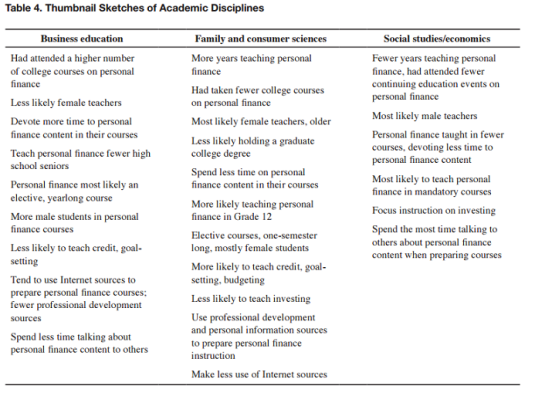The articles I chose to look at today were ones mentioned in the Loibl & Fisher article I discussed yesterday. I chose to look at these two because they were on the list of articles that found either no or negative correlations between high school financial education and financial behaviours.
I went in to these two readings expecting to discover the worst about how financial education in high school does not work- but I am not feeling that way. Liobl & Fisher referred to the Tennyson & Nguyen article as showing no correlation for finance education, but the article suggested that there was an improvement for test scores for individuals required to take a personal finance course in high school but not for states that simply had broadly defined curriculum mandates. I entered this course thinking the stand-alone personal finance course was the best option, and I am becoming convinced that way once again. The Peng, Bartholomae, Fox, & Cravener found no improvement for students that took a high school course, but they did find improvement for students that took a course in college. They suggested that this could be due to the timing of offering the education at a time when students were taking on higher levels of personal financial responsibility.
One of the things that stood out to me from the Tennyson & Nguyen study was how low the test scores were overall- even for students who had taken a Personal Finance course and planned to attend four-year college or university programs. Average quiz scores were still under 60%. I think this is a testament to the fact that better financial literacy education is desperately needed. I do not think they are easy concepts to teach, but I think that the difficulty of the material increases the need for the development of good education for these concepts. I believe that the alternative is a society that doesn’t have a lack of money, but a society that will never be debt-free due to a lack of money management skills.

It also stood out to me that the average difference in test scores, while considered significantly different, was less than 5% on the mean score. While a few of these articles are challenging my statistics knowledge- this stands out to me as being a modest increase in test performance after investing resources to teach a full course on Personal Finance to all students.
Tennyson & Nguyen also considered race, future educational plans, and parent’s education when looking at the test scores and there were no surprises that being a Caucasian student from a home with educated parents and plans to attend a four-year college or university program scored the best. What did surprise me a bit was that there weren’t any measurable differences in gender performance.
The Peng, Bartholomae, Fox, and Cravener research found that a college personal finance class was more beneficial for students than a high school course. This, also, isn’t surprising as this course would come at a time when students are making some of their own financial decisions for the first time and the learning is more meaningful because they are learning information needed immediately. This is something that has continued to concern me: Is high school too early for students to learn these financial skills as they won’t be likely to need them at the time? This is a concern I hope to address after further research, but the alternative of offering personal finance courses in college or university means that you are missing a large number of students that will never make it to these places- likely the students that need the skills the most.
As mentioned in my previous entry, I think these articles brought to light concerns with the implementation of broadly outlined mandates and highlights a need for more than just a public-pleasing mandate, but instead a full mandatory personal finance course offered by well trained teachers. I acknowledge that this is not an easy task, but I personally feel it is both a valuable investment and one that is long overdue. I think that a high school level personal finance course would need to try to create experiential learning opportunities for students and find ways to make the learning meaningful for students in order for it to be successful.
One of the questions I am left thinking about at this point is whether or not increasing student knowledge will actually improve consumer behaviours. Next I intend to look at the Bernheim, Garrett, and Maki study as it has been referenced several times in the readings I have done and I am hoping it can address this question.
~
“Recent economic challenges have highlighted the importance of teaching our kids to understand personal finance. The day-to-day relevance of economic concepts and financial responsibility will only continue to increase as the world is rapidly transformed by science and technology. Providing students with the practical tools they need to apply that knowledge will help them succeed financially by creating businesses, driving innovation, and achieving personal dreams. Working together, we can infuse our classrooms with the necessary foundational capabilities and make financial education a centerpiece of our public and private agenda.”
–Richard D. Fairbank, Founder, Chairman, and Chief Executive Officer, Capital One Financial Corporation
B
Blog Entry #9 More financial literacy education fails
Research is stacking up against financial literacy education. Most recently I read Mandell & Klein’s study: The Impact of Financial Literacy Education on Subsequent Financial Behaviour. While they used a small sample size (79 students), they were able to use students that had similar educational experiences and they were able to know, for certain, which students had taken a Personal Finance course from school records rather than just asking participants to remember their education on the survey. These were also students from a school with a highly regarded Personal Financial Management class, not just a school where it was mandated to have a course offered. The findings of the survey showed that students who took the course were no more financially literate than those who had not. The students that took the course were also no more likely to identify as savings-oriented and did not seem to have better financial behaviours than those who did not take the course.

It boggles my mind to think that offering a full course in financial management to students does not have an effect on their financial behaviour or knowledge within 1-4 years time. I feel like there is such an established need for this education, but why is it not working when it is being offered? One of the reasons that I have thought about is that students are learning information that is not relevant to them at the time. It would be like me learning about retirement options now- not one of my highest priorities, so the information is less likely to stick in my mind. Most students in high school are not financially independent and thus are not a captive audience for the much-needed financial management knowledge. I also think that there is not a lot of importance placed on personal finance and financial literacy in schools, and as a result we have untrained teachers taking on the classes, not teaching from an area of passion. I also don’t think students place a high value on the content of the class, making their learning less influential on the own lives.

I especially can’t get my mind around the Jump$tart surveys and their results showing students with no course in personal financial management out-performing the students who have taken a course. Students are actually doing worse on the assessment after taking the class? I am left wondering what it is about the content of a personal finance class that could produce results such as these. Surely students don’t perform worse after taking Math, Science and English classes- otherwise there would be a lot of teachers searching for jobs. Is there something unique about the content of personal financial management? Are the concepts too difficult for a high school senior? I personally wouldn’t think so- especially for the average/higher achieving students. While I can see the student disinterest factor having an effect, I wouldn’t have guessed it would have that much of an effect. You should still have your students that are going to learn the content required of them, no matter what that content is. These students should be improving the test scores on the Jump$tart surveys, and that is not the case. Are there too many factors affecting the ever-changing field of personal finance? Again, I wouldn’t have thought this would be the case for most high school students if they were able to be taught in a classroom with a well-educated, effective teacher.
I started studying financial literacy education because I felt like there was a need to teach it here in Saskatchewan to help the next generation avoid the financial mismanagement problems my generation is experiencing. What I am finding, however, is that the results are inconclusive about whether or not there is ANY improvement on financial behaviours from these educational efforts. As a teacher I have been taught to think (and teach others to think) that knowledge is power and that by learning about things we can change the way we live accordingly. It is hard for me to accept that educating students in financial literacy won’t create adults with better financial management skills. I find myself questioning: what are some alternate education options to change the financial literacy of our province? When should financial literacy skills be taught? Early in my blog entries I looked at what Ontario is doing: mandated finance education in every subject Grades 4-12. Will this be more effective than a single Senior year course? Do we need the finance education to be continuously repeated year after year to create the knowledge base and attitudes needed for the Personal Finance course that should be taught in senior year? Or, is personal finance something people have to learn about the hard way through personal experience or modelling in a family environment? I am struggling with a lot of these difficult questions as I feel there is more and more research showing that financial education mandates are not the simple solution I came into this course expecting would change the financial literacy of our SK students. I have not abandoned the idea of a need to teach these skills, I am just feeling like I need to do more research to find out how we can teach these skills effectively, rather than just teach them to satisfy public demand.
The Mandell & Klein article referred to different studies that paint a more positive picture for financial literacy. Hilgert, Hogarth, and Beverly (2003) found that financial knowledge is related to financial behaviour. Elliehausen, Lundquist, and Staten (2003) found that credit counselling improved borrowing behaviour and creditworthiness. Hirad and Zorn (2001) found that pre-purchase counselling programs completed by home buyers decreased delinquency rates. To me this shows that financial literacy education is able to influence financial behaviours, but may suggest that the timing of the learning is high in importance for the learning.
One of the big drawbacks of the Mandell & Klein article (that they recognise and discuss in the Summary section) is the fact that it only follows high school students for the first 5 years after graduation (ages 18-23). It is likely that many of the survey participants do not fully manage their own finances yet and have not experienced many of the personal financial management behaviours that will come. I am interested in knowing if the skills and attitudes learned in high school finance courses affect individuals after this time as they navigate through many of their first big financial decisions. I wish the study had repeated itself 5 years later to see if the same results presented.
~
“I feel very strongly that America will never truly get public spending under control unless we as Americans culturally change the way our personal finances are managed.” –Lynn Fitch, Mississippi State Treasurer
B
















